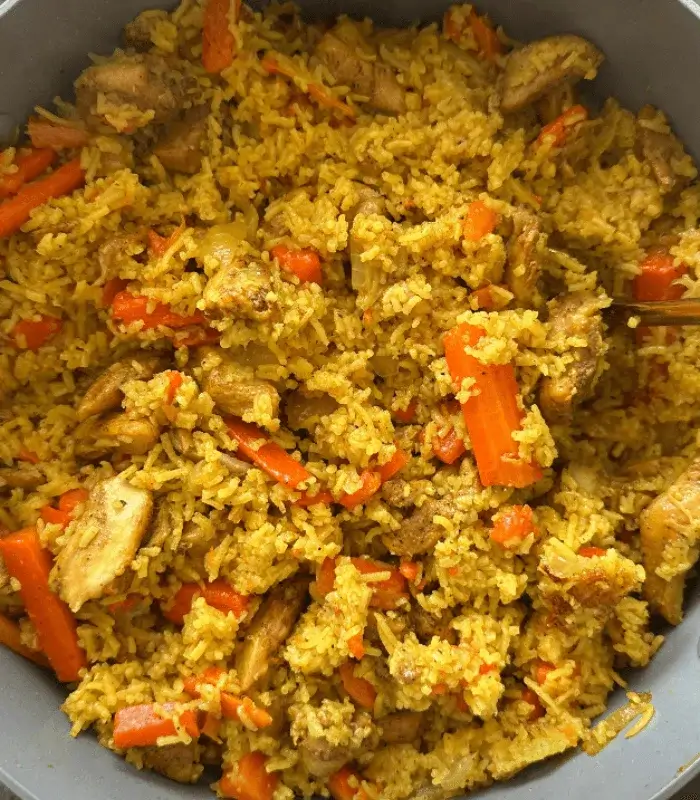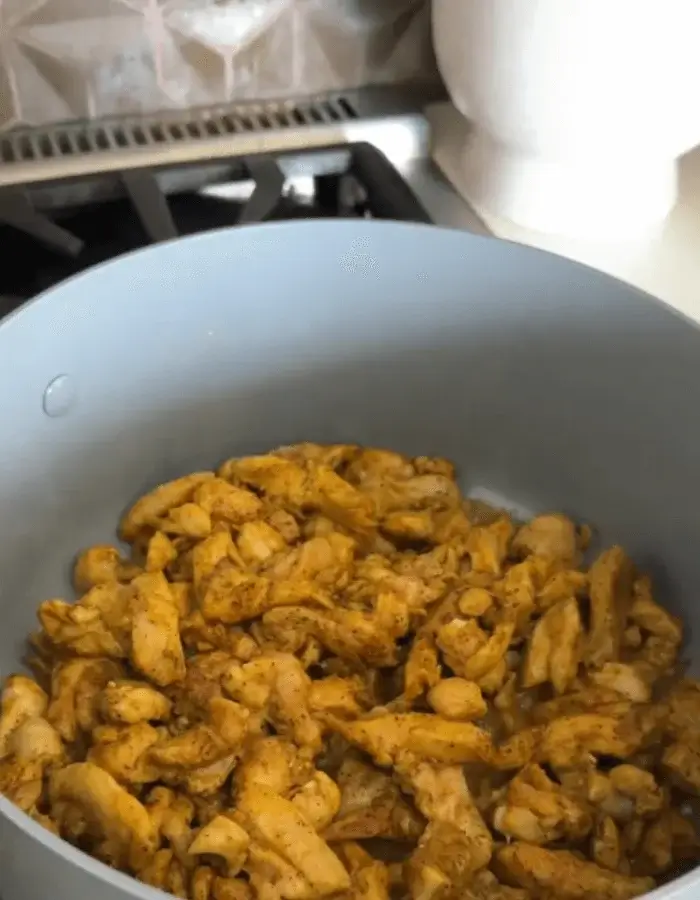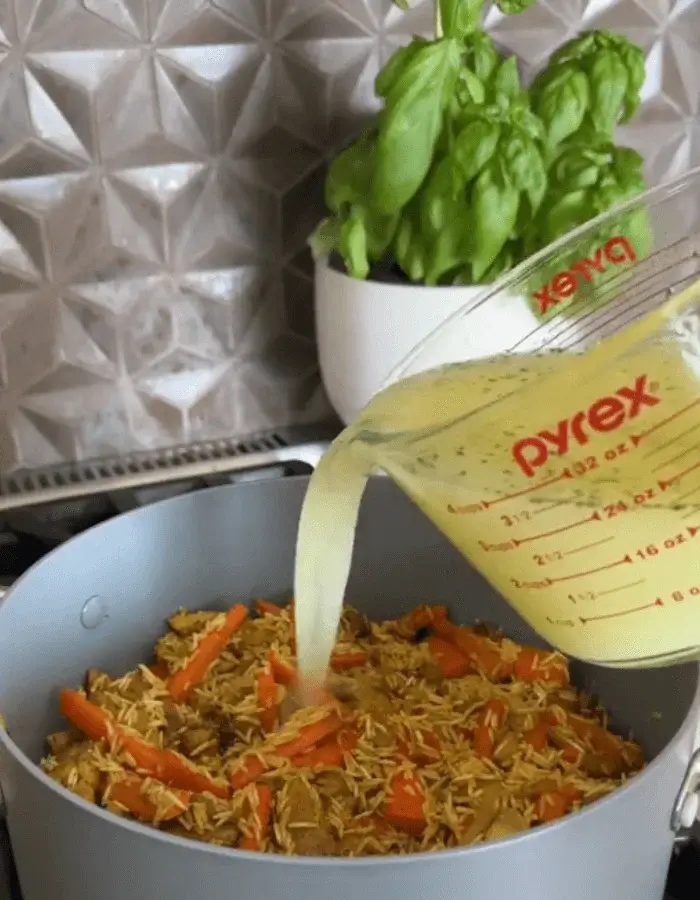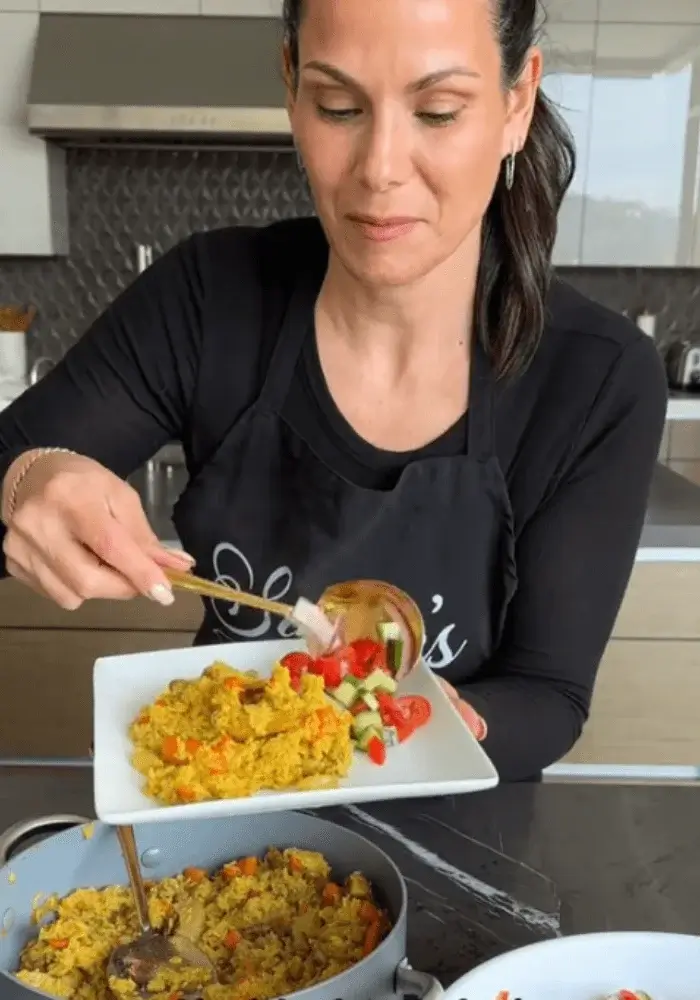Spiced Chicken Pilaf with Basmati Rice
We may earn a commission from recommended products, at no extra cost to you. See Disclosure.
- Large mixing bowl
- Chef's knife
INGREDIENTS
- 1½ pounds/680 grams boneless, skinless chicken thighs, cut into strips or cubes
- 1 large onion, roughly chopped
- 5 medium carrots, peeled and cut into thick slivers
- 2 teaspoons ground turmeric, divided
- 2 teaspoons curry powder, divided
- 2 teaspoons ground black pepper, divided
- 2 teaspoons salt, divided
- ½ cup olive oil, divided
- 2 cups basmati rice, washed and drained
- 3 cups chicken stock
INSTRUCTIONS
- In a large bowl, combine the chicken with 2 tablespoons of olive oil, 1 teaspoon each of turmeric, curry powder, black pepper, and salt. Toss to coat and set aside.
- Heat a large nonstick pot or Dutch oven over medium heat. Add the chicken and cook, stirring occasionally, until lightly browned and just cooked through, 5 to 7 minutes. Transfer the chicken to a bowl, leaving the juices in the pot.
- Add the onion and sauté until softened, about 3 minutes. Add the carrots along with the remaining 1 teaspoon each of turmeric, curry powder, black pepper, and salt. Cook, stirring frequently, for 2 to 3 minutes until fragrant.
- Add the rice and stir to coat in the oil and spices. Return the chicken and any accumulated juices to the pot, mixing thoroughly.
- Pour in the chicken stock and bring to a boil over high heat. Once boiling, stir gently, reduce the heat to low, cover, and simmer for 20 minutes, or until the rice is tender and the liquid is absorbed.
- Remove from the heat and let the pilaf rest, covered, for 5 minutes. Fluff gently with a fork before serving.

FAQ
How can I make this chicken pilaf vegetarian or vegan?
You can easily replace the chicken with protein-rich alternatives like chickpeas, tofu, or tempeh. Chickpeas work especially well, offering a firm texture and the ability to absorb the flavors of the spices and stock. Substitute the chicken stock with vegetable broth, and sauté the plant-based protein in olive oil with the same spice blend used for the chicken. Follow the rest of the recipe as written, making sure to adjust seasoning to taste.

What kind of rice works best for chicken pilaf?
The best rice for chicken pilaf is long-grain basmati rice. It cooks up light, fluffy, and aromatic, making it ideal for absorbing the spiced broth without clumping or turning mushy. Basmati rice’s slender grains and mild flavor complement the bold spices and chicken in the pilaf. Make sure to rinse the rice thoroughly until the water runs clear, which removes excess surface starch and helps keep the grains separate during cooking. Avoid using short-grain or sticky rice varieties, which are prone to becoming gluey in a dish like chicken pilaf.
Can I use chicken breast in chicken pilaf?
You can use boneless, skinless chicken breast in chicken pilaf, but the texture will be slightly different. Chicken thighs remain juicier and more flavorful when simmered, while breast meat can dry out more easily. If using chicken breast, cut it into even-sized pieces and take care not to overcook it in the browning step. You may want to slightly reduce the sauté time and add the cooked breast meat back to the rice closer to the end of the simmering period to avoid dryness. Adjust seasoning as needed since breast meat is milder than thighs.
How do I keep the rice from getting mushy?
Use the correct rice-to-liquid ratio—here, it’s 2 cups/400 grams basmati rice to 3 cups/720 milliliters stock. Be sure to rinse the rice thoroughly before cooking to remove excess starch, which can cause clumping and a gummy texture. Once the liquid is added and the pot is covered, avoid lifting the lid while it simmers. Cook on low heat and resist over-stirring. After the pilaf is done, let it rest covered for 5 minutes, then fluff gently with a fork. These steps ensure fluffy, well-separated grains of rice.
What should I serve with chicken pilaf?
Chicken pilaf pairs well with cool, crisp sides to contrast its warm spices and hearty texture. A simple cucumber and tomato salad with lemon juice and olive oil adds brightness. Yogurt-based sauces like tzatziki or plain Greek yogurt offer creamy balance. For a fuller meal, consider flatbread, a side of hummus, or a green salad with a citrus vinaigrette. If serving a crowd, roasted eggplant or grilled zucchini are excellent accompaniments.

Can chicken pilaf be made ahead and reheated?
Once cooked, let the pilaf cool completely, then transfer it to an airtight container and refrigerate for up to 3 days. To reheat, add a splash of water or chicken stock to restore moisture, then warm gently on the stovetop over low heat or in the microwave. Covering the pilaf while reheating helps retain steam and prevent drying. Stir occasionally to distribute heat evenly. If the rice seems too dry, add a bit more liquid. Chicken pilaf also freezes well for up to one month if stored properly.
Can I add other vegetables to this recipe?
Bell peppers, peas, green beans, zucchini, or spinach can be added during different stages of cooking. For firm vegetables like bell peppers or green beans, sauté them with the carrots and onions. For tender vegetables like spinach or frozen peas, stir them in during the last few minutes of cooking so they retain color and structure. Be mindful not to overcrowd the pot, as excess moisture from too many vegetables can affect the rice texture in chicken pilaf.
Can I make this pilaf in a rice cooker or Instant Pot?
The pilaf can be made successfully in a rice cooker or Instant Pot with a few adjustments. For a rice cooker, sauté the seasoned chicken and vegetables separately, then add everything, including the rinsed rice and broth, to the cooker and proceed as usual. For an Instant Pot, use the Sauté function to brown the chicken and vegetables. Add the rice and broth, then seal and cook on high pressure for about 6 minutes with a natural release of 10 minutes.

